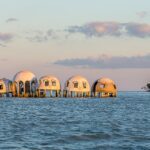Dutch Institute for Sound and Vision: Preserving and Showcasing the Essence of Dutch Audio-Visual Heritage
Established in 1997 as the Netherlands Audiovisual Archive, the institute, now known as Sound & Vision, has evolved into a multifaceted institution, encompassing a cultural archive, a museum, and a vital hub for the nation’s audio-visual heritage. This article delves into the architectural, historical, and cultural aspects of the Dutch Institute for Sound and Vision, capturing its essence as a guardian of Dutch creativity.
Architectural Sensation
The institute’s striking presence is owed to the Vision of Neutelings Riedijk Architects, who embarked on the construction of this cultural haven in May 2004. The modern architectural style, a signature of Neutelings Riedijk, seamlessly integrates with the dynamic landscape of Hilversum. The construction, completed in November 2006 for 40 million Euros, resulted in a sprawling complex spanning 30,000 square meters with a height of 26 meters.

Function and Purpose
More than a mere repository of audio-visual artifacts, the Dutch Institute for Sound and Vision serves a tri-fold purpose:
It is the business archive for national broadcasting corporations, preserving the diverse tapestry of Dutch television and radio history.
It operates as a cultural heritage institute, opening its doors to students and the general public. It provides unparalleled access to over 750,000 hours of television, radio, music, and film.
Sound & Vision functions as a museum, offering visitors an immersive journey through the evolution of Dutch media.
Cultural Archive and Museum
Sound & Vision’s role as a cultural archive is monumental, curating and safeguarding over 70% of the Dutch audio-visual heritage. This extensive collection, which began in 1898 and continues to grow daily, positions the institute among Europe’s most extensive audiovisual archives. The archive includes various media, from historical radio broadcasts to contemporary television productions, creating a comprehensive tapestry of Dutch cultural evolution.
As a museum, Sound & Vision provides a captivating experience for visitors, allowing them to explore the evolution of media in the Netherlands. The digital television production workflow and extensive digitization efforts preserve historical content and pave the way for innovative services, bridging the past and future of media consumption.

European-Funded Research Initiatives
Sound & Vision’s commitment to advancing media extends beyond preservation and exhibition. The institute actively engages in European-funded research projects, breaking new ground in peer-to-peer fusion, digitization, and web archiving. The institute’s involvement in projects like PrestoSpace, VIDI-Video, and Video Active highlights its dedication to pushing the boundaries of media technology.
Merger with Muziekweb
On January 1, 2022, the Netherlands Institute for Sound & Vision welcomed Muziekweb in a significant development. Muziekweb, formerly associated with the Central Library of Rotterdam, brought with it the distinction of being “Europe’s largest music collection.” This strategic merger further solidifies Sound & Vision’s position as a comprehensive hub for preserving and celebrating diverse facets of Dutch cultural heritage.
Visiting Sound & Vision
For those eager to explore the rich tapestry of Dutch media history, the Dutch Institute for Sound and Vision opens its doors from Tuesday to Sunday between 10:00 and 17:00. Located at Media Park, Sumatralaan 45, Hilversum, the institute welcomes inquiries at +31 35 677 5555 and invites virtual exploration through its website: https://beeldengeluid.nl/.
The Dutch Institute for Sound and Vision stands as a physical edifice and a living testament to the dynamic and evolving nature of Dutch audio-visual heritage. From its architectural marvel designed by Neutelings Riedijk Architects to its pivotal role as a cultural archive, museum, and research hub, Sound & Vision embodies the spirit of preservation, innovation, and accessibility. As it continues to grow and adapt to the changing media landscape, the institute remains a beacon for those seeking to connect with the soul of Dutch creativity.
Further Information On Dutch Institute for Sound and Vision in Hilversum Netherlands
Date Construction Started: May 2004
Date Opened: November 2006
Cost Of Building: 40 million Euros
Architect: Neutelings Riedijk Architects
Architectural Style: Modern
Size Or Floor Area: 30000 m2
Height: 26 meters
Function Or Purpose: Museum
Address: Media Park, Sumatralaan 45, Hilversum, The Netherlands
Phone Number: +31 35 677 5555
Website: https://beeldengeluid.nl/
Opening Hours: Tue-Sunday:10:00-17:00




